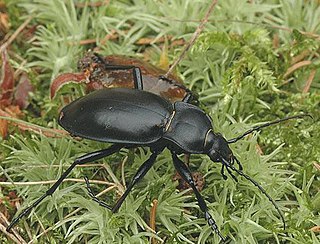
Ground beetles are a large, cosmopolitan family of beetles, the Carabidae, with more than 40,000 species worldwide, around 2,000 of which are found in North America and 2,700 in Europe. As of 2015, it is one of the 10 most species-rich animal families. They belong to the Adephaga. Members of the family are primarily carnivorous, but some members are phytophagous or omnivorous.

Monochamus is a genus of longhorn beetles found throughout the world. They are commonly known as sawyer beetles or sawyers, as their larvae bore into dead or dying trees, especially conifers such as pines. They are the type genus of the Monochamini, a tribe in the huge long-horned beetle subfamily Lamiinae, but typically included in the Lamiini today.

Carabus is a genus of beetles in family Carabidae. The genus is highly diverse with 94 subgenera, 959 species and 2300 subspecies, thus is the largest genus in the subfamily Carabinae. The vast majority are native to the Palearctic, but 16 Nearctic species are also known. Carabus spp. are 12–50 mm (0.47–1.97 in) long, and most species are wingless and often very colourful. These are nocturnal, predatory beetles that feed on snails, earthworms, and caterpillars. Most Carabus species were thought to have inhabited the Eurasian forest, but the species' low dispersal abilities altered the distribution of lineages within the genus.

Cybister, is a genus of beetle in family Dytiscidae. They are found in much of the world, including all continents except Antarctica. As of 2021 there are 96 species and 9 additional subspecies among four subgenera in the genus.

Ceroglossus is a genus of beetles in the family Carabidae, whose members are restricted to Chile and Argentina. The genus contains the following species:

Lebiinae is a subfamily of ground beetles in the family Carabidae. There are more than 330 genera and 6,300 described species in Lebiinae, in 5 tribes.

Calybe is a genus of beetles in the family Carabidae, containing the following species:

Nebriinae is a subfamily of ground beetles in the family Carabidae. There are about 12 genera and more than 840 described species in Nebriinae.

Carabus hummelii is a species of ground beetle in the family Carabidae. It is found in China, North Korea, Russia, and Mongolia.

Epicauta is a genus of beetles in the blister beetle family, Meloidae. The genus was first scientifically described in 1834 by Pierre François Marie Auguste Dejean. Epicauta is distributed nearly worldwide, with species native to all continents except Australia and Antarctica. Surveys have found the genus to be particularly diverse in northern Arizona in the United States. Few species occur in the Arctic, with none farther north than the southern Northwest Territory of Canada.

The Aleocharinae are one of the largest subfamilies of rove beetles, containing over 12,000 species. Previously subject to large-scale debate whether the subfamily deserved the familial status, it is now considered one of the largest subfamilies of rove beetles.
Lesticus buqueti is a species of ground beetle in the subfamily Pterostichinae. It was described by Castelnau in 1834.

Ceroglossus chilensis, the Chilean magnificent beetle, is a species of beetle of the family Carabidae.

Tillinae is a subfamily of beetles in the family Cleridae, the checkered beetles.

Xenion ignitum is a species of ground beetle in the family Carabidae, found in southeast Europe and Turkey.

Omalium is a genus of ocellate rove beetles in the family Staphylinidae. There are at least 70 described species in Omalium.

Colon is a genus of round fungus beetles in the family Leiodidae. There are at least 80 described species in Colon.
Ceroglossus darwini is a species of beetle in the family Carabidae. Eight subspecies are currently recognized.
Ceroglossus magellanicus is a species of beetle in the family Carabidae. Eighteen subspecies are currently recognized.
Allocotocerus is a genus of water beetles in the family Hydrophilidae, first described by Ernst Gustav Kraatz in 1883. The decision for synonymy is based on Hansen (1999).
















